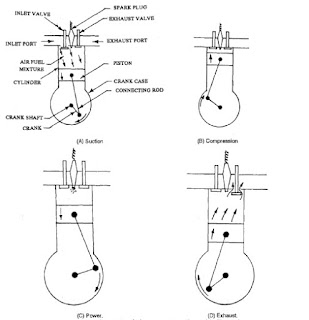The four stroke engine comprises of suction, compression, power or working and exhaust strokes.
1. Suction Stroke: When the piston moves from TDC to BDC the inlet valve opens and due to the downward movement of piston a partial vacuum is created in the cylinder above the piston. Due to this partial vacuum air is sucked in at the end of stroke the inlet valve closes.
2. Compression Stroke: When the piston starts moving from BDC to TDC the air which has been trapped in the cylinder starts getting compressed, when the piston reaches near TDC, the trapped air gets so compressed that its temperature reaches between 5000C to 6500C. this higher increase in temperature is because of higher compression ratio, in this stroke both valves remain closed.
3. Power Stroke: At the end of compression stroke diesel oil is sprayed in fine atomized form to the burning hot air which has attained temperature of approximately 5000 to 6500C here we would like to mention that self ignition temperature of diesel fuel at atmospheric pressure is 3500C to 4500C as such atomized fuel in hot air gets ignited in more or less rapid explosion making gases to expand. We have earlier studied that piston is the only moving part in the cylinder.
4. Exhaust Stroke: In this stroke, the exhaust valve opens and due to moving of piston from BDC to TDC, the burnt gases are pushed out. The inlet valve opens in suction stroke but as a matter of fact it opens 100 to
220 before TDC in exhaust stroke. So that valve is fully open when piston starts moving down and enough time is given for air to get it. The inlet valve remains open in compression stroke 200 to 300 after BDC. This
once again is to allow air which was coming to cylinder to cylinder with great velocity to fill cylinder completely.

No comments:
Post a Comment